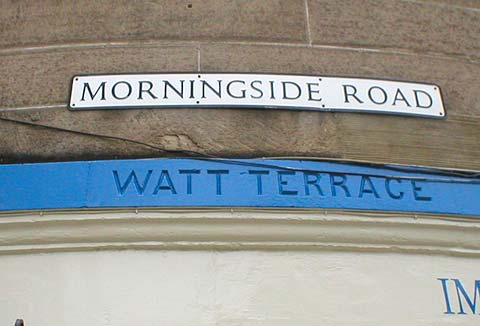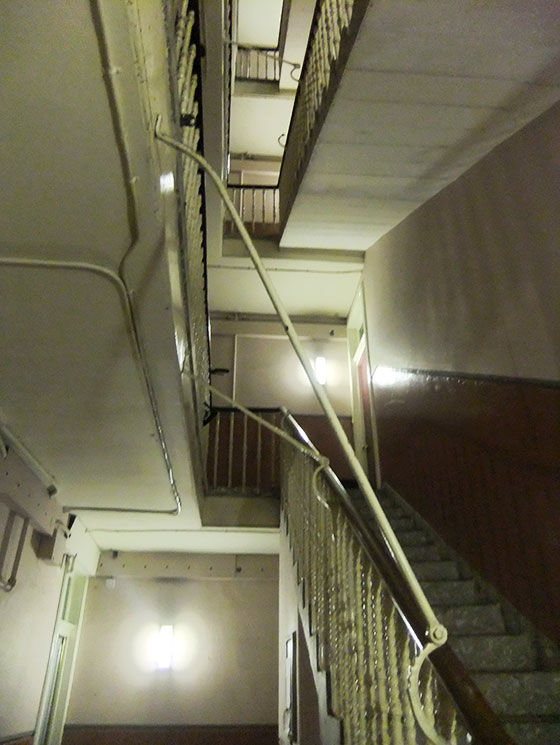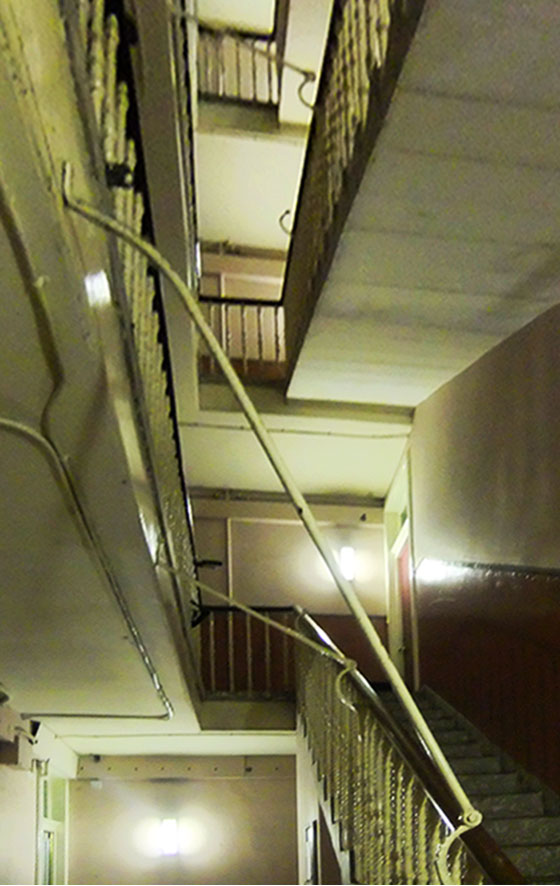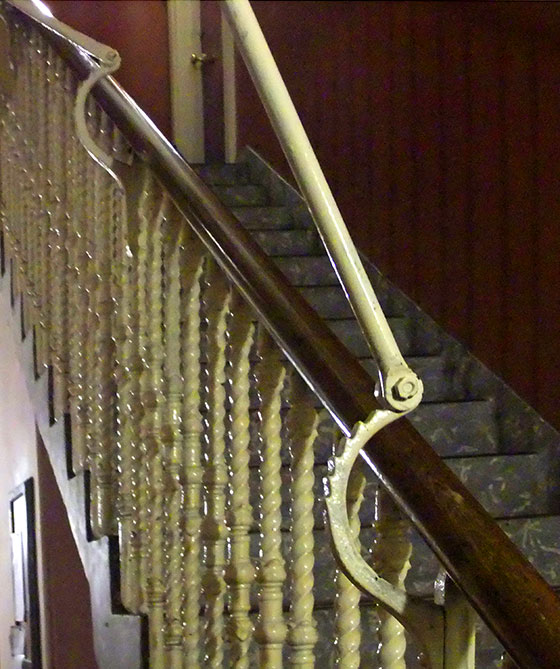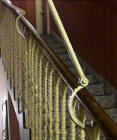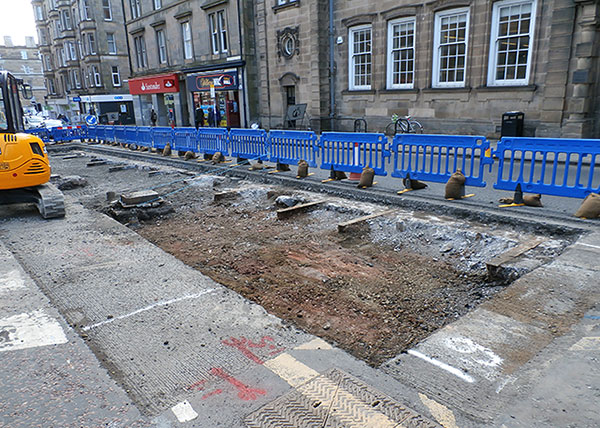|
Morningside About 1.5 miles south of the centre of Edinburgh |
|
Recollections |
||
|
1. |
Fiona
Osborn |
The Seaton Family |
|
2. |
John Gray |
Watt Terrace |
|
3. |
John Leslie |
William Leslie, Butcher |
|
3. Reply 1 |
William Leslie, Butcher |
|
|
3. Reply 2 |
William Leslie, Butcher |
|
|
4. |
Maurice McIlwrick |
Golf Courses |
|
4. Reply 1 |
David Coates |
Ladies' Golf Course |
|
5. |
Ian Taylor |
Golf Course at Morningside |
|
6. |
Margaret Williamson (née Hay) |
Launderettes |
|
7. |
Alex Jackson |
Bannister attachments |
|
7. Reply 1. |
Bob Henderson |
Bannister attachments |
|
7. Reply 2. |
John Gray |
Bannister Attachments - Some other purpose? Bus Platforms |
|
Peter Stubbs |
||
|
7. Reply 3. |
Bob Henderson |
Bannister attachments |
|
7. Reply 4. |
Simon Capaldi |
Bannister attachments |
|
7. Reply 5. |
Alex Jackson |
Bannister attachments |
|
7. Reply 6. |
Graham Ferguson |
Bannister attachments - Wobbly Bannisters? |
|
7. Reply 7. |
Joyce Lamont Messer |
Bannister attachments - Moving Furniture? |
|
7. Reply 8. |
John
Chittenden |
Bannister attachments - Sliding hands down bannister |
|
8. |
Jonathan Berk |
My Dissertation - Growing up in Morningside - A Conversation |
|
9. |
Peter Hoffmann |
Baird's Newsagents - Early Rise for the Paper Round - Inside the Shop - Pamela Baird - The Paper Runs - My Paper Run - Magazine Inserts - Solitary figures - Character Building - Company - Poem The 1960s - An Age of Change - Music |
|
10. |
Balcarres Street - Gents' Toilets |
|
|
11. |
Terry Cox |
Question - Road Works |
|
Recollections 1. Fiona Osborn Tasmania, Australia |
|
Fiona Osborn writes: |
|
The Seaton Family "My mother Jean Sharp Seaton (Hogg) was born in 1924 at Morningside. She lived there until joining the army to serve in London in 1939. Her older sister was Mary, and their parents were William and Jane Seaton (née Peebles). She did her hairdressing apprenticeship in Edinburgh and returned after the war to marry Martin Hogg in 1949 at Morningside Church. I was hoping that some of your contributors might remember Jean or know of the hairdressing salon in Edinburgh where she did her apprenticeship." Fiona Osborn, Tasmania, Australia: August 15, 2010 |
|
Reply to Fiona Osborn If you'd like to send a reply to Fiona, please email me, then I'll pass on your message to her. Thank you. Peter Stubbs: August 15, 2010 |
|
Recollections 2. John Gray Stenhouse, Edinburgh |
|
It may have been seeing the photos of the old street signs in Leith that prompted John Gray to write: |
|
Watt Terrace "Here's another old Edinburgh street name confined to the history boos. The location is the bottom of Morningside Road, at the corner of Maxwell Street."
© John Gray, Stenhouse, Edinburgh John Gray, Stenhouse, Edinburgh: May 18, 2018 |
|
Recollections 3. John Leslie Edinburgh |
|
William Leslie, Butcher John Leslie is looking for photos of his father's butcher's shop: William Leslie, Butcher, 45 Comiston Road, Morningside, John remembers delivering messages from this shop as a child in the 1960s and 1970s. John's brother, Bill, went on to own the shop, until the 1990s. |
|
Replies to John? If you know of any photos of this shop, or have any memories of the shop that you'd like me to add to the EdinPhoto web site, please email me, then I'll pass on your message to John. Thank you. Peter Stubbs, Edinburgh: August 19, 2011 |
|
Recollections 3. Reply 1. Janette Gollan |
|
Thank you to Janette Gollan who replied: |
|
William Leslie, Butcher "I remember William Leslie's butcher's shop very well. My grandfather, Alex Stewart, worked there during the 1960s. We lived in Balcarres Street. I too was a child in the 1960s. I can remember John and his brother, Billy, as well as their father, William. I was born in 1959 and would imagine John might be round about my age or a wee bit older." Office in the Shop "There used to be a wee office in the shop where a woman dealt with all the delivery orders and cash. The delivery bicycle used to be propped outside the shop and a boy (John?) used to deliver. I also remember the big walk-in freezer and, through the back, where we used to watch my granddad make their own potted meat, sausages and white pudding. I always maintain that's why I don't eat any of these things now!" Office in the Shop "Unfortunately I don't have any photos of the shop, but it has been nice to recollect. I've just remembered that there was a wee sweet shop round the corner (Permans?) where we used to go." Janette Gollan: 8 November 2012 |
|
Recollections 3. Reply 2. Milne Gordon |
|
Thank you to Janette Gollan who replied: |
|
William Leslie, ButcherI "I've just come across the EdinPhoto web site and the page of recollections of Morningside. I worked at John Leslie’s butcher shop on Saturday mornings from about 1952/53 until probably 1955. I went into the RAF in 1959 and I can remember when I came back a while later, on leave to visit my parents at Craiglea Drive, that the shop had been modernised. I took a photograph of the shop but unfortunately I have no idea where it is now. I've just come across this web site and I see that the article above about the butcher’s shop was in 2011, so my reply is a bit late." Milne Gordon |
|
Reply to Milne Hello Milne: There is no need to be concerned about your reply being a bit late. I always appreciate replies, whenever they arrive. Sometimes I get responses within half an hour of posting a question on the web site; on other occasions it has taken ten years or longer to receive a response! Peter Stubbs, Edinburgh: July 26, 2015 |
|
Recollections 4. Maurice McIlwrick
|
|
McIlwrick, author of the book, 'Golf in West Edinburgh' asks a couple of questions: |
|
Maurice wrote: Question 1 Golf Course at Morningside "Is anybody able to help regarding a golf course in Morningside area, somewhere in the region of Nile Grove / Blackford. It may have had the name Bloomsbury Golf Club, Blackford Brae, Canaan Lane or even The Ladies Golf Club as I believe it was exclusively for ladies. It possibly disappeared due to the development of housing in the area at the time of World War I." Maurice added: Question 2 Other Golf Courses "In my book, 'Golf in West Edinburgh', I tried to cover all the courses, past and present in an area going out as far as Pumpherston / Linlithgow. I'm now contemplating either extending the book to cover all of Edinburgh or issuing a new book for the East of Edinburgh. Does anybody have any information dealing with the history or unusual features of any of the golf courses in and around Edinburgh? If so, I would be interested to hear about it. I found 37 for the West, but needless to say another five have since come to light in the area that I covered, so Iwant to be sure this time to cover them all if possible." Maurice McIlwrick, North Gyle, Edinburgh: August 8, 2012 |
|
If you would like to contact Malcolm in connection with either of the questions that he asks above, please email me to let me know, then I'll pass on your message to him. Thank you. Peter Stubbs, Edinburgh: September 24, 2012 |
|
Recollections 4.
Reply
to Question David Coates Livingstone, West Lothian, Scotland |
|
Thank you to David Coates who replied: |
|
Golf Course at Morningside "I don’t know if anyone has answered Maurice’s question about Blackford Brae Ladies Golf Course, but having lived in Morningside as a child from the 1970s, and as an adult worked at the Astley Anislie Hospital for many years, I had never heard of any golf course in that area, until I was looking at old maps of the area on the National Library of Scotland / maps website. There I found, in the Bart Survey Atlas 1912, at the East end of Cluney Avenue, Blackford Brae Ladies Golf Course. Not knowing anything about it, I Googled it to see if there was any info about it or pictures, which brought me to your pages. I hope that, even though it is 4 years on, this helps Maurice" David Coates, Livingstone, West Lothian, Scotland: 9 December 2016 |
|
Recollections 5. Ian Taylor South Glasgow, Scotland |
|
Thank you to Ian Taylor for sending a reply to Question 1 above. Ian wrote: |
|
Golf Course at Morningside "The golf course Maurice refers to is probably the one marked on the Edinburgh and Leith map of 1915, south section, directly across Cluny Gardens from Blackford pond, beyond the western end of Mortonhall Road. This land is now occupied by an extension of the Astley Ainslie hospital, something to do with the ever mushrooming Napier University." Ian Taylor, South Glasgow, Scotland: September 24, 2012 |
|
Recollections 6. Margaret Williamson (née Hay) Moline, Illinois, USA |
|
Thank you to Margaret Williamson (née Hay) who wrote: |
|
Launderettes My Aunt Bebe worked as nanny to Mr McCauley (a lawyer) who owned and opened a launderette at Pilrig, so my mum was lucky to get a job there for a year or so. Then he opened one in Morningside where my mum worked for a long time. Here is a photo of her in the Morningside launderette: Mum at Morningside Launderette
© Reproduced
with acknowledgement to I used to go to the launderette after school and help. I filled the soap and bleach, swept dusted and helped fold for some of the people. When the launderette first opened, you had to sit and wait,. Then then Mr McCauley offered a service where you could leave laundry and pick it up later. That .made a lot of people happy." The Auld Wash Hooses "What a change that was from the auld wash hoosees ,where I used tae go and use the scrub board mangle, and horse dryers (as they used to call 'em). But in a way, looking back, it was fun at the auld wash hooses, where the women would get together and chat or gossip." Margaret Williamson (née Hay), Moline, Illinois, USA: December 3 + 10, 2012 |
|
Recollections 7. Alex Jackson Mortonhall, Edinburgh |
|
Thank you to Alex Jackson for sending me the photo below of a bannister attachment in one of the tenements at Morningside. Alex asked: |
|
Question Bannister Attachments "Here is a photo of one of the bannister attachments in a tenement at Balcarres Street, Morningside. These attachments are all the way up the bannister to the top floor. Looking closely at this photo, three of these attachments can be seen on the bannister. These now appear to be redundant for whatever use they were intended. Whatever their use was now puzzles me. Could they, perhaps, have ben used in some way for hanging washing? Does anybody know? Photo 1. Bannister and Attachments in a Balcarres Street Tenement © Alex Jackson, Mortonhall, Edinburgh Alex Jackson, Mortonhall, Edinburgh: January 5, 2014 |
|
Reply to Alex Jackson? I wonder if these might have been just decorative devices to stop people from sliding down the bannisters. If you know or can speculate on the purpose and use of these attachments, please email me (peter.stubbs@edinphoto.org.uk) to let me know, then I'll give you Alex's email address so that you can send a message direct to him. Thank you. Peter Stubbs, Edinburgh: January 5, 2014 |
|
Recollections 7. Reply 1. Bob Henderson Burdiehouse, Edinburgh |
|
Thank you to Bob Henderson for replying to the question from Alex Jackson in Recollections 7 above. Bob wrote |
|
Bannister Attachments "These bannister attachments were just another way to stop youngsters sliding down the bannisters. I vaguely remember several serious accidents whilst sliding down bannister this, when I was young." Bob Henderson, Burdiehouse, Edinburgh: January 5, 2014 |
|
Recollections 7. Reply 2. John Gray Stenhouse, Edinburgh |
|
Thank you to John Gray who wrote: |
|
Bannister Attachments "I, too, have always wondered about these attachments on the bannisters. I see lots of these in stairs whilst working. These attachments have a kind of ratchet on one side and a round top with a hole in it. I would have thought that if they were purely for stopping you sliding down the bannisters they would have just been a plain piece of metal. I wonder what these pieces were originally made for. Also, they used to put little diamond shaped gold plated raised studs in the bannisters to stop you sliding down them, but as I remember, you just drew your stomach in whilst sliding down, and most times you made it down the bannisters ok - but it was sore if you miscalculated. Today's Health & Safety Exec. would have a fit seeing kids sliding down stair bannisters as fun back in those days. Bob Henderson, Burdiehouse, Edinburgh: January 5, 2014 |
|
Health & Safety Bus Platforms I agree with your Health & Safety Exec. comments above. Another practice that the would not have approved of was use of the open platform on buses, mainly in the 1950s to 1970s, in my case: - chasing after the bus that had departed and on catching up to it, jumping onto the platform. This could be quite a challenge amongst the traffic, especially when the platform was already full of people who had just jumped on. It became a matter of holding onto whatever handles or bits of bus that came to hand until the platform cleared. - dismounting from the bus platform by lowering one leg towards the ground then removing the second leg from the platform and starting a 'full speed run to leave the bus as it passed the end of your street at about 15mph. Peter Stubbs, Edinburgh: January 24, 2014 |
|
Recollections 7. Reply 3. Bob Henderson Burdiehouse, Edinburgh |
|
Thank you to Bob Henderson for commenting again on the question from Alex Jackson in Recollections 7 above. Bob wrote |
|
Bannister Attachments "Just a thought about the ring at the top of these attachments ... It could have had a rope threaded through it. The placement of these attachments at the corners, as seen in the photo, would have lent itself to this. The bowed shape of these attachments would allow one to slide one's hands up or down the bannister without having to let go of it." Bob Henderson, Burdiehouse, Edinburgh: January 24, 2014 |
|
Recollections 7. Reply 4. Simon Capaldi Sheriffhall, Midlothian, Scotland |
|
Thank you to Simon Capaldi who wrote: |
|
Bannister Attachments "Could these bannister attachments have been used for hanging pot plants of flowers? I've seen this in other tenement stairs." Simon Capaldi, Sheriffhall, Midlothian, Scotland, January 24, 2014 |
|
Recollections 7. Reply 5. Alex Jackson Mortonhall, Edinburgh |
|
Thank you to Alex Jackson for writing again, this time sending two more of his photos of bannister attachments in Balcarres Street tenements at Morningside. Here are the two photos, followed by comments from Alex. |
|
2. Bannister and Attachments in a Balcarres Street Tenement showing some sort of supporting rods fixed to the top of the bannister attachments © Alex Jackson, Mortonhall, Edinburgh 3. Zoom in to Bannister and Attachments showing some sort of supporting rods fixed to the top of the bannister attachments © Alex Jackson, Mortonhall, Edinburgh Bannister Attachments "These two photos are of another stair in Balcarres Street, Morningside. They give a fuller picture of what was attached to the top of the brackets, but I'm still not clear what these attachments were for." Alex Jackson, Mortonhall, Edinburgh: February 13, 2014 |
|
Recollections 7. Reply 6. Graham Ferguson Saudi Arabia |
||
|
Thank you to Graham Ferguson who wrote: |
||
|
"After seeing the photographs from Alex Jackson,
it looks to me like an over-engineered solution to wobbly bannisters." Graham Ferguson Saudi Arabia: February 14, 2014 |
||
|
Thank you, Gordon Thanks for your comments, Graham. That makes sense to me. I've never seen anything like that before! Peer Stubbs, Edinburgh: February 14, 2014 |
|
Recollections 7. Reply 7. Joyce Lamont Messer Whanganui, North Island, New Zealand |
|
Joyce Lamont Messer wrote: |
|
Bannister Attachments Moving Furniture "Were these bannister attachments, perhaps, to help move heavy furniture into the flats by using ropes threaded through the attachments? I believe that I might have been told this, once, as a child. I certainly cannot imagine they were to hold flowering baskets or to stop children sliding down. They must have had a far more practical purpose." Joyce Lamont Messer, Whanganui, North Island, New Zealand: February 15, 2014 |
|
Recollections 7. Reply 8. John Chittenden Fife, Scotland |
|
Thank you to John Chittenden who replied. |
|
Bannister Attachments Sliding Hands down the Bannister "I suspect that this this style of bannister attachment was used because it would support the bannisters and also allow you to slide your hand down the bannister and not get it trapped as, for example, in Kingdom Centre, Dunfermline." John Chitterton, Fife, Scotland: August 12, 2013 |
|
Recollections 8. Jonathan Berk Edinburgh |
|
Jonathan Berk wrote: |
|
My Dissertation Growing up in Morningside "I'm a MSc student at the University of Edinburgh. I've been working on my dissertation in which I'm talking to people about in two neighborhoods of Edinburgh. I wonder if you possibly knew anyone who might be willing to talk to me about their experiences growing up / living in Morningside or Leith. I’m part of a research project called Edinburgh Speaks, and we’re looking at how people in Edinburgh get along and communicate with each other. We’re visiting a number of neighbourhoods and communities within the city to talk to people about their experiences living here. We’re interested in learning about how they see their neighbourhood, the rest of Edinburgh, and other places in Scotland. A Converstion "If you’re interested in participating, I’d like to have a conversation with you. I’ll ask you some questions, and you can answer however you’d like. I’d like to record what you say, but your information will be kept completely anonymous (or, if you prefer, we can make sure you receive credit for your contribution to this project)." Jonathan Berk, Edinburgh: June 25, 2014 |
|
Reply to Jonathan Berk? If you'd like to reply to Jonathan, and possibly participate in his project, please email me to let me know, then I'll pass on Jonathan's email address to you. Peter Stubbs, Edinburgh: June 26, 2014 |
|
Recollections 9. Peter Hoffmann Highlands, Scotland |
|
Thank you to Peter Hoffmann for the message that he sent. Peter wrote |
|
Bairds’ Newsagents Early Rise for the Paper Round "From behind the keyboards it's easy to romanticise the past. And it's also too easy to romanticise about getting up early to do a morning paper run, and pontificate about its character-building qualities. Getting up at a quarter to six on dark mornings was rarely easy; even if you had gone to bed early the night before. However, once you had got over the initial shock of the Big Ben repeater alarm going off, and with a mug of tea and toast into your system, it was fine. Travelling down to Bairds' Newsagents at Morningside Drive for our paper rounds on the 6.00 a.m. No.16 bus wasn't too bad in the winter months. The bus was cosy, the company of Liz, Fiona and Gail Blades and Christina and Maureen Hogg was good and the craic between the conductor and the cleaners was funny." Inside the Shop
"Once
we were inside the shop we were out of the cold, the wet and the
dark, and could temporarily keep the
winter at bay. For half an hour it
was quite Dickensian, with a mini-factory
at the back of the shop, where we folded thousands of newspapers
on the worktop surface, in preparation for the arrival of the
owner and manager, Pamela Baird, to make up our paper runs.
Being Morningside, most
of the newspapers were broadsheets. Liz and Fiona were like
robots. The speed at which they folded the papers was uncanny;
they were lightning fast. I could never keep up with them.
However, when they weren't about I enjoyed appearing fast to the
novices. When we had finished, our
hands were black from the newspaper ink. Pamela Baird "I liked Pamela and warmed to her. I admired the way she assumed responsibility for the business after her father died. She wasn't an 'early morning person', so it was a struggle for her too. And running the business must have placed a heavy burden upon her slim shoulders.
In the afternoons she was
much lighter-natured and could be good
fun. I wonder what became of her
in the decades after the shop was sold. Her
mum, Josie McRae (Baird) passed away in June 2013. Pamela came from a different social class to us. When Pamela answered the telephone she put on a posh accent for the benefit of her customers; there would be exaggerated pauses as she said 'Mmmh, yaass....mmmh yaass...mmmh yass'; Fiona and I would give one another knowing smiles and glances." The Paper Runs "I liked working for Bairds. However, one thing which brassed me off was that although we arrived at the shop half an hour earlier than the children from Morningside, Pamela would always make up their runs first. I always felt this was favouritism and class discrimination. They were the children of Pamela’s friends and neighbours who attended local schools such as George Watson's College. However, Fiona was smart as a whip and actually memorised her run so she didn't have to hang around for Pamela to arrive." My Paper Run "I did the Morningside Drive run. It was one of the biggest runs at the shop. I had to collect a second bundle of papers from Pamela's brother, Stuart, who dropped it off from his little Triumph Herald open-top car on to the garden wall at St Clair Terrace, but irritatingly, he was usually late. Although this was effectively a double paper round, Bairds paid well. At a pound a week, it was double the going rate and a daily sixpence for our bus fares was paid for too. I felt a sense of ownership too. Despite the size, length and time taken to complete the round I regarded the Morningside Drive run as mine (until I took over the City Hospital run from Douglas Blades) and took a certain pride in ensuring the mail got through, no matter the obstacles." Magazine Inserts "Tuesdays or Fridays were the worst days because the Daily Telegraph had introduced a magazine insert which added considerably to an already heavy bag. Saturday bags were also heavier, with the weekend magazine, but somehow, Saturdays never seemed a struggle." Solitary Figures "Once the paper boys and girls had set out from the warmth and company of the shop, we cut lonely, solitary figures. The winter mornings were dark and often quite bitter. Morningside Drive was quiet. The graveyard was on the opposite side of the road for a stretch. Lovely mansion and town houses by day were surprisingly spooky and shadowy in the dark, especially when the wind blew through the swaying, leafless branches of the big old trees that lined Morningside Drive." Character Building "Looking back it was certainly character building. It was partly because of these early morning sojourns that, in later years I took athletics training in my stride. Undoubtedly they had steeled and inured me. And whilst I see a certain value in the overall experience, it was not conducive to performing well at school and reaching your potential. Indeed, when my younger son asked me, a few years ago, if he could do an early morning paper run, whilst I admired his chutzpah and work ethic, I said 'no'. Instead, I wanted him to get as much sleep as possible to grow and to be fresh for school. And today, I guess we're more aware of the health and safety dimension too." Company
"Paper
runs were mainly done alone. On
the rare occasions when I had company, the run was a doddle.
Sometimes my sister, Anne, would accompany me on Saturday
mornings. During the run I would send her up to a house to deliver
a newspaper. When she came back,
I'd vanished behind a tree or a wall, only to leap out and scare
her. I'm afraid I haven't changed much-my younger son (19) and I
(59) still do the same to each other! The other person I occasionally paired up with was Fiona Blades. Sometimes it was to learn a new run for which I might have to provide holiday cover, or simply to learn a new run that I was to take future responsibility for. Raymond Carver's poem, Happiness, (below), captures some of the feelings of doing a paper round in company." Poem
"So
early it's still almost dark out.
I'm near the window with
coffee,
and the usual early
morning stuff
that passes for thought.
When I see the boy and
his friend
walking up the road
to deliver the newspaper.
They wear caps and
sweaters,
and one boy has a bag
over his shoulder.
They are so happy
They
aren't saying anything, these boys.
I think if they could,
they would take
each other's arm.
It's early in the
morning,
and they are doing this
thing together.
They come on, slowly.
The sky is taking on
light,
though the moon still
hangs pale over the water.
Such beauty that for a
minute
Death
and ambition, even love,
doesn't enter into this.
Happiness.
It comes on
unexpectedly. And goes
beyond, really, any early morning talk about it." The 1960s An Age of Change "The 1960s were very much an age of change, a rapid movement from the austerity of the 1940s and 1950s to the pop movement of the 1960s, with a change of attitudes, embracing a youth culture in clothes, music and technology. All the way from Hong Kong the advent of technology made a positive impact on the quality of life on our early morning paper runs. We could now work to music!" Music
"In
the late 1960s there was an explosion of cheap mini radios that
came on to the market. For many of us of a certain age it was a
'must have'
purchase. Instead of solitary
contemplative walks we could now enjoy the dubious charms of Tony
Blackburn on the Radio 1 'Breakfast Show'.
I recall on one occasion
when Fiona Blades and I
teased an old Postie
who we were friendly with. I'd got
a tiny, minuscule plastic toy radio out of a Lucky Bag; although
the technology was fast moving, it hadn't quite reached that stage.
However, we tried to pass it off to him as being the real
thing, whilst we had the mini radio switched on, but hidden in my
paper bag. He held it up to his ear and declared it ‘a
marvelous thing!’ Peter Hoffmann, Highlands, Scotland: 9 August 2015 |
|
Recollections 10. Rob J Penman |
|
Rob J Penman wrote: |
|
Balcarres Street "There used to be a Victorian gents' toilet at the beginning of Balcarres Street. It was a red sandstone building which had some of the best examples of Victorian sanitary ware and tiling. It was demolished without thought. Today, it would have had a preservation order on it." Rob J Penman: 10 March 2016 |
|
Reply to Rob Gents' Toilets in Edinburgh Yes, Rob. The building may well have had a preservation order placed on it today - but it might still have been closed by the council. Over the past year the City of Edinburgh Council has closed several public conveniences around Edinburgh as a 'cost saving' measure. One Edinburgh public convenience that I remember from an earlier period, when I arrived in Edinburgh in the 1960s was the large gents' toilet down the steps below the pavement at the east end of Princes street, in front of Register House. I remember the daylight shining into it through the glass skylights set in the pavement. I wonder if it is still there, buried and forgotten beneath the ground. Peter Stubbs, Edinburgh: 13 March 2016 |
|
Recollections 11. Terry Cox Fairmilehead, Edinburgh |
|
|
Thank you to Terry Cox for sending me the photo and question below. Terry wrote: |
|
|
Road Works at Morningside © Terry Cox, Fairmilehead, Edinburgh Question "At the moment a bit of the roadway in Morningside is being re-laid. I was a bit surprised to see that there are a row of RSJs embedded under the road - see photo above. I wonder if any of your readers would know what they are there for. My instant reaction was to think old trams, since they are in the middle of the road, but they don't seem to be deep enough to allow a layer of setts on top. having said that, road levels are always a bit iffy. They tend to be raised over time. Anyway, just wondered if anyone knew their purpose." Terry Cox, Fairmilehead, Edinburgh: 22 February 2017 |
|
|
Questions for Terry Cox Before adding the photo above to the web site, I emailed Terry and asked him: 1. What does the abbreviation 'RSJ' stand for? 2. Had he thought of asking any of the workers or their foreman if any of them could answer his question. Terry Replied: |
|
|
Replies from Terry Cox RSJs "RSJ is Rolled Steel Joist or I-beam (capital i). According to the Wiki definition:
The Workers "I'll try asking the workers, but as RSJs have not been put in by these guys, I'm not too hopeful. Terry Cox, Fairmilehead, Edinburgh: 23 February 2017 However, Terry subsequently wrote: "Unfortunately by the time I got back to Morningside (on Friday) the workers had filled it all in and a new bunch of guys were laying tar over it! However I did speak to a couple of friends, who well remember the trams. One of them, John Stenton, who worked in construction with Millar, says that he has seen this arrangement, which is effectively sleepers for tram rails. However, he thought it was only done at junctions, where there were likely to be lateral forces on the tram rails. This makes sense, except that the bit in Morningside is in the middle of a long straight! So it might still be worth asking the question on your web site. Terry Cox, Fairmilehead, Edinburgh: 28 February 2017
|
|
|
Reply to Terry If you'd like to respond to Terry's comments above, please email me to let me know, then I'll pass on Terry's email address to you. Thank you. Peter Stubbs, Edinburgh: 28 February 2017 |
